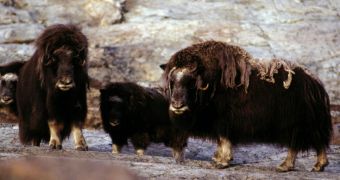Most people living in the United States and Canada know very little about the musk oxen, a large herbivorous mammal that has roamed the land for millions of years. Only small populations endured to this day, and conservations are currently renewing their efforts to protect the species.
Although it's listed as LC (least concerned) on the International Union for Conservation of Nature's (IUCN) Red List of Threatened Species, this animals is experiencing ups and downs that merit closer attention, biologists say.
The Arctic animal (Ovibos moschatus) lives largely in the frozen areas of North America, while smaller populations were also reintroduced in Sweden, Siberia and Norway, after being hunted to extinction.
At some of these location, the musk oxen thrives, and populations are holding at a low, yet steady level. In some other areas however, the animal is losing the battle with extinction, and experts don't seem to know why.
Determining the reasons for why this happens was the driving force behind a new scientific study on the issue. The research group also included experts from the Wildlife Conservation Society (WCS).
According to historical records, muskox went extinct in Alaska around the 1880s. After more than a century, in the 1970s, they were reintroduced in the area thanks to conservation efforts.
It is estimated that more than 3,500 to 4,000 musk oxen exist in the area today, of which only 10 to 30 inside the Arctic National Wildlife Refuge of Alaska, Our Amazing Planet reports.
Scientists don't yet know what caused this significant drop in numbers, considering that more than 400 individuals lived in the Refuge in the 1990s.
The new study aims to understand how come musk oxen populations declined so rapidly in an area that was set up to protect them, and foster population growth, says WCS expert Joel Berger.
There are very few known cases of poaching against this majestic creature, and the only natural predators it has, except humans, are grizzly bears and polar bears.
However, the musk oxen are fairly good at defending themselves. A herd will typically form a circle around the calves, with all the bulls and cows pointing their heads outwards. This solid block is often deterring for pack predators such as wolves, which generally fail to find a way in.
During the investigation, researchers also hope to bring the least known large mammal of America back into public view, which is bound to aid in future efforts to conserve the species.
“People may think Pleistocene relics exist only in museums or that animals with a highly ordered social structure like elephants exist only in Africa or Asia, but actually they exist here in the American wild,” Berger explains.
“We're just starting to unlock the clues that will inform the conservation of these amazing animals, and to spread the word about what a national treasure they truly are,” he adds.

 14 DAY TRIAL //
14 DAY TRIAL //